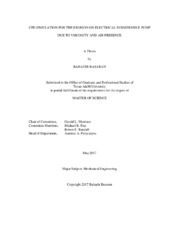| dc.contributor.advisor | Morrison, Gerald L. | |
| dc.creator | Basaran, Bahadir | |
| dc.date.accessioned | 2017-08-21T14:29:53Z | |
| dc.date.available | 2017-08-21T14:29:53Z | |
| dc.date.created | 2017-05 | |
| dc.date.issued | 2017-01-04 | |
| dc.date.submitted | May 2017 | |
| dc.identifier.uri | https://hdl.handle.net/1969.1/161268 | |
| dc.description.abstract | There is a necessity to use artificial lift when the natural drive of oil is not strong enough to push the oil from the well bottom to the surface. Electrical Submersible Pump (ESP) systems have been used far and wide by the petroleum industry to compensate the need of lift. The pump part of an ESP system needs to deal with the erosion due to both slurry working conditions and the presence of air. Presence of abrasive particles can erode hydraulic as well as secondary flow paths which can lead to damage of the pump resulting in affects ranging from performance degradation to pump failure.
This study is focused on CFD (Computational Fluid Dynamic) based evaluation of erosion in ESP pump section under different operating conditions. The pump was modelled at 3600 rpm at best efficiency point for different viscosities such as 1cp, 5cp, 20cp and 60cp. Two gram/liter of sand was introduced at the inlet of the pump. Eulerian approach was utilized to model the two phase flow simulation using ANSYS Fluent. An erosion model developed in the Turbomachinery lab for the pump was utilized to predict the erosion. The developed equation was compared with inbuilt ANSYS erosion prediction equations using the DPM approach. Erosion rates as a function of viscosity across different sections of the pump were obtained and compared with previously published data.
From the previous erosion testing of ESPs, it is learned that erosion rates accelerated in the presence of gas. The CFD study was undertaken to evaluate the effect of gas presence on erosion rates. The two phase flow simulation was conducted to evaluate the effect of bubble size on flow separation and pump performance. A three phase flow simulation was performed for the first time using 850gpm water, 15 % GVF (Gas Void Fraction) of air and 2grams/liter of sand. The study concludes with a discussion about the effect of bubble size on phase separation erosion modeling in presence of gas and potential improvement required to calibrate the three phase flow simulation. | en |
| dc.format.mimetype | application/pdf | |
| dc.language.iso | en | |
| dc.subject | ESP | en |
| dc.subject | viscosity | en |
| dc.subject | erosion | en |
| dc.subject | CFD | en |
| dc.subject | pump | en |
| dc.title | CFD Simulation for the Erosion on Electrical Submersible Pump Due to Viscosity and Air Presence | en |
| dc.type | Thesis | en |
| thesis.degree.department | Mechanical Engineering | en |
| thesis.degree.discipline | Mechanical Engineering | en |
| thesis.degree.grantor | Texas A & M University | en |
| thesis.degree.name | Master of Science | en |
| thesis.degree.level | Masters | en |
| dc.contributor.committeeMember | Randall, Robert | |
| dc.contributor.committeeMember | Pate, Michael | |
| dc.type.material | text | en |
| dc.date.updated | 2017-08-21T14:29:53Z | |
| local.etdauthor.orcid | 0000-0002-1567-9437 | |


